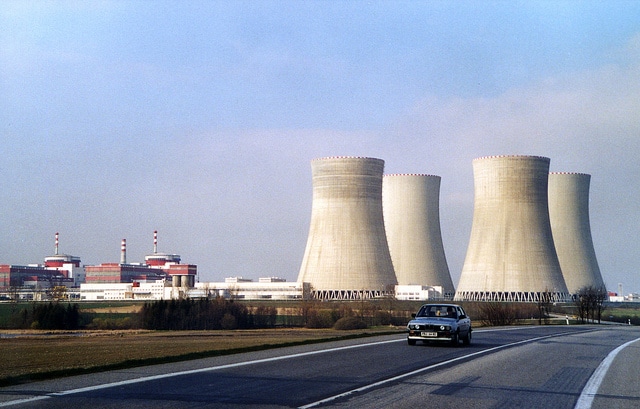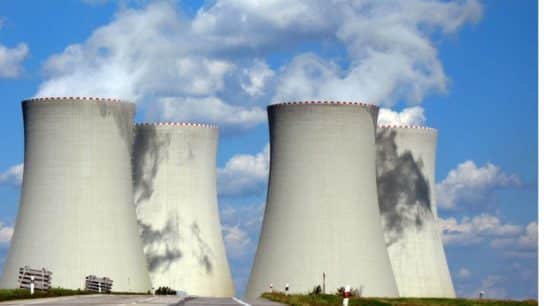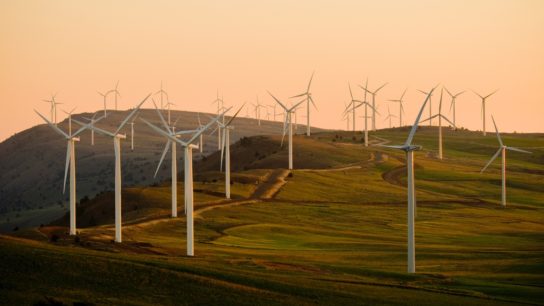In 2011, Germany’s parliament passed legislation that would phase out all nuclear energy power plants in the country by 2022. The decision was made in the immediate aftermath of the accident at the Fukushima Daiichi nuclear power plant in Japan, when the plant’s cooling systems failed following a 9.0 magnitude earthquake and tsunami, causing three reactors to melt down. With its nuclear phase-out, Germany accelerated a larger global trend towards denuclearisation of energy grids, in no small part due to plant safety concerns following the Fukushima incident. The phase-out has come at a price, however; the German government largely replaced nuclear with coal-powered plants, which have been releasing an additional 36 million tonnes of CO2 annually and causing the premature deaths of 1,100 people per year due to ambient air pollution. Nuclear energy certainly has its risks, but a quantified analysis of the impacts of nuclear phase-outs beckons the question: is energy denuclearisation sensible policy, or is it simply rooted in unmerited alarmism?
—
Nuclear energy has had a short, but tempestuous history. The late 19th and early 20th centuries saw several milestone breakthroughs in atomic science, as some of the world’s brightest minds began to understand how the tremendous potential energy held within the nuclei of atoms could be harnessed. America was the first country to successfully employ nuclear power, introducing the world to its terrifying might on August 6, 1945, in Hiroshima, Japan. This was arguably one of the most pivotal moments of modern human history, an event that killed nearly 150 000 people, violently closed the curtain on the Second World War and ushered in the Cold War, an era of geopolitical relations and technological and military capabilities defined by nuclear power.
After WWII, the focus turned towards how nuclear energy could be put to use for commercial purposes. Controlled nuclear reactors were first used for naval propulsion, and then for electricity generation beginning in the early 1950s, when the first commercial nuclear fission reactors hit the market.
Nuclear fission taps into the potential energy stored in the bonds within atoms of heavy elements. When these atoms are split, they release large amounts of energy that can be used to generate electricity. In a nuclear reactor, a neutron particle is fired at an atom of a heavy element, normally uranium, causing the atom to break apart and produce energy in the form of heat. When a neutron collides with a heavy atom, more high-energy neutrons are released and collide with more atoms, creating a chain reaction. Power plants are equipped with a variety of safeguards to keep chain reactions under control, including a constant water supply to cool down reactors and injectable control rods composed of chemical elements that can absorb neutrons but are not fissibile.
The costs of nuclear power plants are considered the main obstacle to nuclear power’s long-term and global feasibility. Nuclear power plants can often be very expensive to construct, and it can be years before any return on investment is provided.
When set up, however, nuclear power plants are relatively cheap to run and are mostly cost-competitive with fossil fuels in terms of electricity generation. This is largely because of nuclear energy’s high efficiency. Nuclear fission requires relatively small amounts of uranium to produce enough energy to stay competitive with other energy sources, with fuel accounting for only 9% of operating costs, compared to 77% for a coal-fired plant and 93% for a natural gas plant. Nuclear power plants also require minimal land use relative to the energy they can generate, a distinct advantage over renewable energy sources which need to occupy large spaces of land to be competitive. Nuclear energy is also a low-carbon energy source, although not zero-carbon. While nuclear energy generation does not release any direct carbon emissions, the mining and refinement of uranium is quite energy-intensive and does release CO2 emissions.
While nuclear energy has several benefits, employing it is risky, and public opinion is strongly divided, with the main criticisms addressing the radioactive waste problem and the risk for catastrophic incidents. The actual risk of these threats coming to pass are subject to ongoing debate, but regardless, nuclear’s potential dangers to humanity and the planet appear much lower than those posed by the energy source that is most likely to replace nuclear, at least in the short term, fossil fuels. When nuclear energy is phased out, fossil fuels tend to be the go-to replacement and can cause more deaths and financial losses that would have been incurred had nuclear power plants remained online for longer.
You might also like: The Advantages and Disadvantages of Nuclear Energy
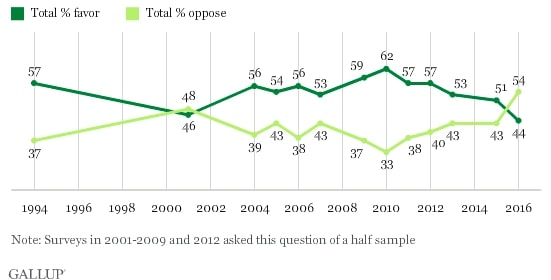
Figure 1: Public opinion on nuclear energy use in the US from 1994 to 2016; Gallup; 2016.
Throughout the mid and late 20th century, nuclear energy was seen as a beacon that could light humanity’s future. Now, it appears that renewable energy sources will take up the mantle of providing for humankind’s energy needs, which is a good thing, considering their relatively minimal risks and lower start-up costs. The problem is that a global energy grid powered by 100% renewable energy is still several decades away, which is time we simply do not have. Nuclear fission could help bridge the transition, but decommissioning our existing and functioning nuclear power plants does nothing to help us in our most important fight: eliminating fossil fuels from our energy grids.
The Real Risks of Nuclear
Since 1952, when nuclear power was first employed for commercial purposes, 33 incidents and accidents have been recorded. Most of these were quite minor, although the only two to record death tolls continue to prevail in the public eye: Fukushima, the most recent nuclear incident, and the 1986 disaster in Chernobyl, Ukraine.
There were 31 deaths directly attributed to the immediate aftermath of the Chernobyl disaster, although the real death toll is difficult to discern and clearly much higher due to the long-lasting health effects of radiation exposure. Long-term mortality projections from radiation exposure are diverse and performed with different methodologies that naturally invite criticism and controversy. The most pessimistic projection was included in a 2006 report by the European Green Party, which estimated that up to 60 000 premature deaths by the year 2065 could be linked to Chernobyl. Most scientific studies have released much lower numbers. The World Health Organization has issued what is accepted as the most accurate projected total death toll, at around 4 000.
While the total eventual death toll of Chernobyl remains controversial, retrospective analyses have revealed the extent to which the disaster was caused by human negligence. The reactor used at Chernobyl, known as an RBMK-1000, employed technology that even for that time was considered dated and unsafe. The hours leading up to the meltdown were marred by several avoidable human errors in judgement and competence. The public response from the waning authoritarian power of the Soviet government was also held back by complacency and deliberate untruths, more concerned about preserving its image and hiding vulnerabilities than actual damage control and mitigation. The lacklustre response delayed the local evacuation for much longer than it should have, needlessly exposing thousands to leaked radiation.
The circumstances in Fukushima were very different from those at Chernobyl. The direct death toll of the Fukushima nuclear meltdown in the 10 years since it occurred stands at one, a plant worker in his 50s who was diagnosed with lung cancer in 2016 and died in 2018. For indirect deaths, tallies range from 573 to 2 202, with virtually all fatalities occurring due to the strain of evacuations. The nuclear meltdown occurred in tandem with a devastating earthquake and tsunami, leaving emergency infrastructure and medical personnel ill-prepared for further stressors. The evacuation effort overall was poorly executed and left many people, mostly elderly, vulnerable to physical and non-physical trauma that added to the indirect death toll. Around 60 000 people were evacuated, and by 2019, fewer than half had returned, mainly because of ongoing concern over leaked radiation into the ocean and groundwater around the site of the power plant. Most of the indirect deaths have been attributed to depression, joblessness, alcoholism, mental health struggles and suicides.
It is unclear what the long-lasting health effects of the Fukushima disaster will be. Academic studies have placed the range of total eventual radiation-related deaths tied to Fukushima at anywhere between none at all to 1 000. Slightly higher rates of thyroid cancer, especially amongst children, have been observed in the area since 2011. However, observers have noted that this is probably due to much higher rates of screening and use of more sensitive equipment.
Unlike Chernobyl, the reactor technology in use at Fukushima was modern, considered safe and equipped with proper containment protocols, and the meltdowns occurred mainly because of a perfect storm of unfortunate but mostly preventable circumstances.
The power plant was located on the coast, sited on a fault line that was known to be vulnerable to earthquakes. When the tsunami struck, the main generators that powered the reactors’ cooling systems automatically shut down. The diesel-powered backup generators were located in areas that were at high risk of damage in the event of an inundation, including the basement and rooms no higher than 13 metres above sea level, offering little protection from the tsunami’s 14 metre-high waves and subsequent flooding. The plant’s design had already elicited warnings from concerned scientists and engineers who had visited Fukushima prior to the incident. After the tsunami struck, 12 of the 13 backup generators at the plant were inoperable and unable to provide a constant water supply to cool down the nuclear reactors, which had already powered down but were still liable to overheat due to a process known as decay heat, heat energy released as a result of radioactive decay. The lack of electricity to power cooling systems is what ultimately led to the meltdown.
Despite poor plant designs and the tragedies associated with the evacuation effort, the Japanese government was largely able to contain the radiation leakage. Only one death has been attributed to radiation exposure, and the data on health effects over the past decade have largely encouraged optimism. The vast majority of adverse impacts have been attributed to the psychological effects of the disaster and the trauma of the evacuation.
This speaks to an altogether different element to nuclear that affects how the public has come to perceive it. Nuclear energy is frightening in its power. It has roots in nuclear weaponry, technology that poses one of the most likely existential risks to human civilisation. It inspires feelings of fear and fascination alike in human beings, which is a major reason as to why popular culture has so extensively dramatised nuclear technology in our modern age.
But this dramatisation can be dangerous. Direct deaths related to radiation exposure from nuclear energy have only occurred in two major plant incidents, around 4 000 from Chernobyl and one from Fukushima. The estimates of deaths related to the Fukushima evacuation range from 573 to 2 202, so the highest estimate of nuclear energy’s total death toll sits at around 6 200. These numbers are clearly based on projections, and do not take into account any worker deaths from mining activities and other occupational hazards related to nuclear industrial setup, but it appears that the optimistic projections have been more accurate. This is a remarkably positive record given that nuclear energy has been in use for over 70 years. What is also striking is that both of these incidents ultimately came down to human error, and could have been easily preventable were better risk aversion measures and transparent emergency protocols put in place.
There are certainly significant risks to nuclear energy. Nuclear meltdowns, while rare, can be catastrophic if management is not up to the task. The radioactive waste issue remains unresolved, and there is always the danger that the enriched uranium used to develop nuclear energy can be repurposed to construct atomic weapons. But as the world barrels further down a self-destructive path of burning fossil fuels and slow implementation of modern renewables, being afraid of nuclear energy might be doing more harm than good.
You might also like: The Nuclear Waste Disposal Dilemma
Energy’s Death Toll
Death tolls associated with energy generation are generally unavoidable. Construction, resource extraction and infrastructure management can be hazardous occupations, and often incur unexpected and accidental tragic costs. Some energy sources, however, are more hazardous than others.
Let’s start with renewable energy. Generally, renewables are very safe, and incur a relatively low death toll and infrequent major accidents, as virtually all deaths are attributable to construction hazards or poor maintenance. A 2016 study performed a risk analysis of different types of modern renewable energy sources and nuclear, finding that between 1950 and 2014, 686 accidents related to renewable energy occurred, causing 182 794 deaths. While the average number of deaths per incident was 267, the median number was zero, meaning that most incidents were minor and non-fatal, and that a small number of catastrophic incidents made up almost all of the deaths. Wind power, for instance, was found to have the highest frequency of accidents, although hydropower was by far the most fatal, being the cause of 97.2% of all deaths.
Hydropower is the most widely-used renewable energy source, occupying more than 54% of total global renewable power generation capacity, which is partly why its death toll is higher than other sources. Mostly, however, hydropower’s undesirable distinction is because of one outlier.
In 1975, Typhoon Nina struck southeastern China, and caused the catastrophic collapse of the Banqiao Dam in Henan province which was storing 492 million cubic metres of water. The resulting onrush of water measured 10 metres high and as much as 11km wide in some areas, travelling up to speeds of 50km per hour. 61 smaller dams and reservoirs failed that day, and the total number of direct deaths from the catastrophe was calculated to be around 26 000 people, which is considered the official death toll by the Chinese government. However, subsequent water scarcity and drinking water contamination led to episodes of famine and epidemics, causing an additional 145 000 deaths, taking the total death toll over 180 000.
While the death toll, direct and indirect, of renewable energy is much higher compared to that of nuclear, this is mostly due to one single catastrophic event. Overall, renewable energy should be considered safer because there is no risk of long-lasting radioactive contamination of the environment. However, it does also appear that incidents related to renewable energy, while mostly non-fatal, are much more frequent than nuclear accidents.
The death tolls of nuclear and renewable energy are absolutely dwarfed by the energy source we depend on the most, and see no sign of abandoning in the near future: fossil fuels. When fossil fuels are burned, either on an industrial scale at a power plant to produce electricity or by individuals simply driving a car with an internal combustion engine, they release toxic particulate matter such as sulphur dioxide, ozone and nitrogen dioxide into the atmosphere. Breathing in these toxins can create a host of medical and health issues, including reduced lung function, respiratory infections, heart disease, aggravated asthma, diabetes and neurological deficiencies in children, strokes and cancer.
The number of annual deaths caused by ambient air pollution continues to rise as new estimates are reached and research is conducted. In February 2020, a Greenpeace study found that 4.5 million deaths each year could be attributed to burning fossil fuels, but an even more recent study, to be released in April 2021, concluded that in 2018 over 8.7 million people had died due to ambient air pollution, one in every five deaths to occur that year.

Figure 2: Percentage of deaths in adults over 14 attributable to burning fossil fuels; The Guardian; 2021.
Fossil fuels have admittedly had a much larger share of the global energy mix throughout history, and even now still account for 84% of our total energy consumption, so a higher share of deaths is to be expected. But when looking at deaths by energy unit generated, disparities between the lethality of fossil fuels and that of renewables and nuclear becomes even starker.
A 2007 study published in the Lancet analysed the different death rates per one terawatt-hour (TWh) of fossil fuels, modern renewables and nuclear power. One TWh is around the energy consumed in a year by 27 000 EU citizens. To supply that much energy in one year, coal would kill 25 people, oil 18 and natural gas 3. Most renewable energy sources would cause one death between every 20 and 50 years to produce that same amount of energy, and nuclear energy would cause one death every 14 years. Given how much more we now understand about ambient air pollution’s effect on human health than when this study was first released, the imbalances between death rates caused by fossil fuels, renewables and nuclear could be much higher.
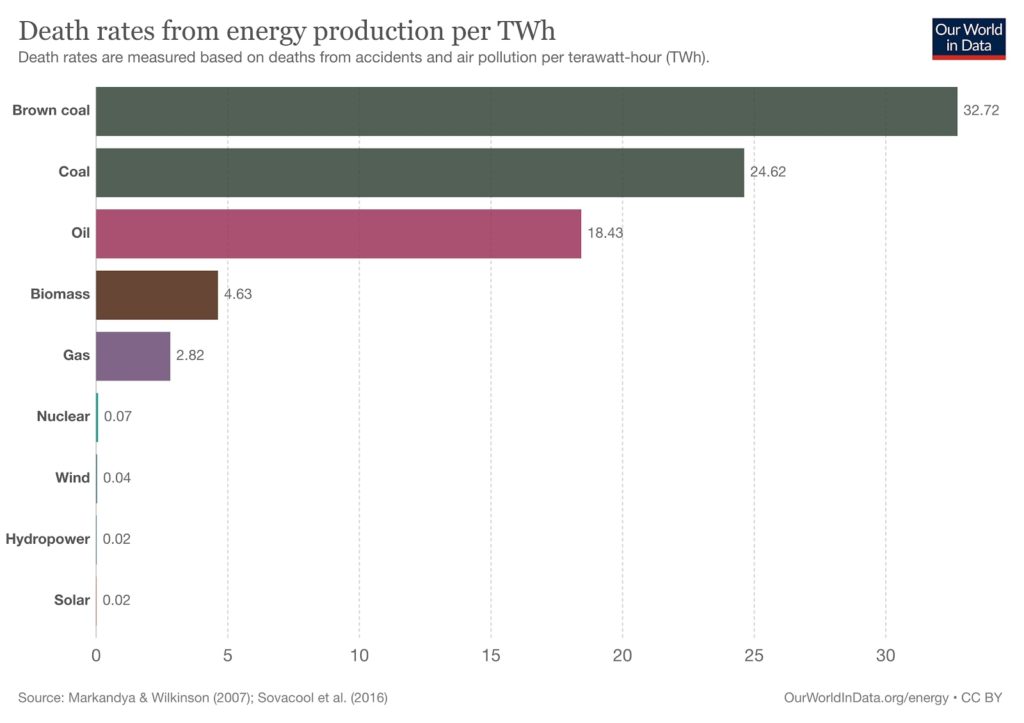
Figure 2: Death rates from energy production per TWh; Data sourced from Makandya & Wilson (2007) and Sovacool et al. (2016). Image by Our World in Data; 2020.
Not only are fossil fuels our deadliest killer from energy generation, but they are also largely able to do so silently. The catastrophic disasters of Chernobyl, Fukushima and the less well-known but deadlier Banqiao Dam failure are sudden, dramatic and easy to assign some emotion to. Burning fossil fuels is different. We cannot see the toxic particulate matter in our air, and yet the subtle killers are there, inflicting gradual harm that is at first unseen but is fast becoming one of the leading causes of death worldwide.
A Bridge to A Better Future
This is why the developments in Germany are so worrying, and the same trend of replacing nuclear energy with fossil fuels is occurring across the globe. Even Japan, which made waves late last year with a 2050 carbon neutrality pledge, has succumbed to its own nuclear trauma, and is actively phasing out nuclear power plants to replace them with coal-powered installations.
The concerns over nuclear energy are of course not entirely unfounded, but the truth is that they are among the safest energy sources we have at our disposal. Until we get our renewable energy technology and infrastructure to a scale where it can provide for all our energy demands, nuclear is the best positioned source to bridge the gap.
But active denuclearisation is anathema to what we should be doing. Setup costs for nuclear energy may be prohibitive, and would impede atomic energy from ever becoming the primary provider for our global energy needs, but that argument doesn’t really carry much weight given that we are phasing out existing and perfectly functional nuclear power plants.
There is even an argument to be made that nuclear energy has saved lives over the past several decades by replacing fossil fuel plants early. A 2013 study commissioned by NASA and co-authored by James Hansen, one of the first scientists to realise the gravity of human-caused greenhouse gas emissions, estimated that, between 1971 and 2009, nuclear energy had saved almost 2 million lives by displacing or preventing more fossil fuels from entering into the global energy mix. The study also found that if nuclear power were to be phased out entirely and replaced with coal and natural gas, up to 7 million people would die.

Figure 3: Mean net deaths prevented annually by nuclear power between 1971-2009 for various countries/blocs; NASA Goddard Institute for Space Studies; 2013.
One of the main arguments levied against nuclear energy revolves around the waste problem. Radioactive waste from uranium fuel can remain at dangerous levels for anywhere from a few decades to 10 000 years, although in reality, only 3% of nuclear waste is radioactive enough that it needs to be separated entirely from the environment and sequestered away for thousands of years.
What this argument also usually tends to neglect is that even without nuclear waste, we are still filling our environment with considerably more toxic waste materials, including poisonous particulate matter and greenhouse gases. Carbon dioxide emissions can stay in the atmosphere invisibly for up to 1 000 years, creating a bevy of positive feedback loops far into the future. Some heavy metals that are found in industrial waste, including cadmium and mercury, are highly toxic and can remain so indefinitely, poisoning agricultural land, fishing waters or freshwater sources used by humans.
The nuclear waste problem is real, but another factor to consider is that there simply isn’t much of it. Worldwide, commercial nuclear power plants have produced the same amount of waste since 1950 that coal plants produce in an hour today. This is mostly because uranium is so energy dense, and nuclear energy generation requires relatively little fuel, which means relatively small amounts of waste. A significant amount of waste can also be reprocessed and reused as fuel, as seen with France’s nuclear reprocessing program, and development of new nuclear technologies would make this process even more efficient.
It would be safer to have small amounts of managed nuclear waste sequestered somewhere underground rather than having unknowable amounts of uncontrolled particulate matter and greenhouse gases roaming freely around our atmosphere and killing millions of people a year while irreversibly changing the Earth’s climate. Nuclear energy is far from perfect, and its high starting costs make it improbable that it could be implemented on a global scale. But it also feels a lot more dangerous and frightening than it actually is, and it can be an important low-carbon alternative to bridge the transition towards 100% renewable energy use, in a time where we have to be taking every action possible to distance ourselves from fossil fuels.
Featured image by: Flickr
This story is funded by readers like you
Our non-profit newsroom provides climate coverage free of charge and advertising. Your one-off or monthly donations play a crucial role in supporting our operations, expanding our reach, and maintaining our editorial independence.
About EO | Mission Statement | Impact & Reach | Write for us




